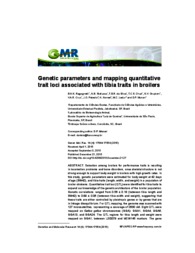Genetic parameters and mapping quantitative trait loci associated with tibia traits in broilers.
Genetic parameters and mapping quantitative trait loci associated with tibia traits in broilers.
Autoria: RAGOGNETTI, B. do N. N; STAFUZZA, N. B.; SILVA, T. B. R. da; CHUD, T. C. S.; GRUPIONI, V. A. R.; CRUZ, V. A. R.; DANTAS, J. de O.; NONES, K.; LEDUR, M. C.; MUNARI, D. P.
Resumo: Abstract: Selection among broilers for performance traits is resulting in locomotion problems and bone disorders, once skeletal structure is not strong enough to support body weight in broilers with high growth rates. In this study, genetic parameters were estimated for body weight at 42 days of age (BW42), and tibia traits (length, width, and weight) in a population of broiler chickens. Quantitative trait loci (QTL) were identified for tibia traits to expand our knowledge of the genetic architecture of the broiler population. Genetic correlations ranged from 0.56 +/- 0.18 (between tibia length and BW42) to 0.89 +/- 0.06 (between tibia width and weight), suggesting that these traits are either controlled by pleiotropic genes or by genes that are in linkage disequilibrium. For QTL mapping, the genome was scanned with 127 microsatellites, representing a coverage of 2630 cM. Eight QTL were mapped on Gallus gallus chromosomes (GGA): GGA1, GGA4, GGA6, GGA13, and GGA24. The QTL regions for tibia length and weight were mapped on GGA1, between LEI0079 and MCW145 markers. The gene DACH1 is located in this region; this gene acts to form the apical ectodermal ridge, responsible for limb development. Body weight at 42 days of age was included in the model as a covariate for selection effect of bone traits. Two QTL were found for tibia weight on GGA2 and GGA4, and one for tibia width on GGA3. Information originating from these QTL will assist in the search for candidate genes for these bone traits in future studies.
Ano de publicação: 2015
Tipo de publicação: Artigo de periódico
Unidade: Embrapa Suínos e Aves
Observações
1 - Por padrão são exibidas publicações dos últimos 20 anos. Para encontrar publicações mais antigas, configure o filtro ano de publicação, colocando o ano a partir do qual você deseja encontrar publicações. O filtro está na coluna da esquerda na busca acima.
2 - Para ler algumas publicações da Embrapa (apenas as que estão em formato ePub), é necessário ter, no celular ou computador, um desses softwares gratuitos. Sistemas Android: Google Play Livros; IOS: iBooks; Windows e Linux: software Calibre.
Acesse outras publicações
Acesse a Base de Dados da Pesquisa Agropecuária (BDPA) para consultar o acervo completo das bibliotecas da Embrapa.

